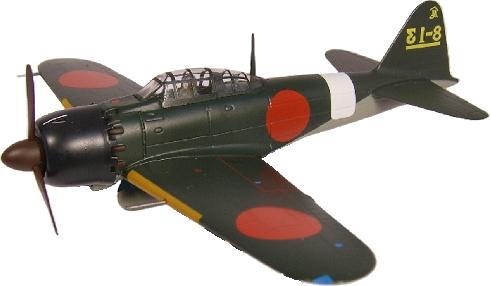


Reisen (Zero Fighter)



Reisen (Zero Fighter)
 A Reisen ( |
| Fuselage- Engine Compartment- Cockpit Canopy- Wings (2)- | 1ØØ 1 6Ø 1ØØ | Tailerons (2) & Rudder- Props (3)- Landing Struts (3)- | 5Ø each 25 each |
Speed and Statistical Data: Weapons Systems 2. Laser Cannons: Set inboard. Features:Maximum speed: 4ØØ mph at 16,ØØØ ft.
Cruising speed: 2Ø7 mph at optimum altitude.
Range In The Air: 2,ØØØ miles typical, 2,5ØØ miles max;
Service Ceiling: 32,81Ø ft.
Climb Rate: 4,517 ft per min.
Takeoff Length: ABOUT 23Ø feet, unassisted.
Landing Length: ABOUT 1ØØ feet, unassisted.
Height: 11 ft. 6 in. (3.51 m).
Wingspan: 36 ft. 1 in. (11 m ).
Length: 29 ft. 11 in. (9.12 m).
Weight: 4,136 lb. (1,876 kg) empty.Operational Weight: 5313 lb typical, 6164 lb max.
Fuel capacity internal: 2ØØ gal.
Fuel capacity external: 1ØØ gal.
Cargo: Pilots supplies only.
Power System:
A single Eto-41 Hydro-Cell Turboprop Engine; Output: 1,5ØØ hp at 1,2ØØ KHw
Flight Systems:
Primary: Aero-Foil Effect.
Secondary: Grav Pods in emergency or for mission-critical VTOL.
Cost and Availability: 5Ø,ØØØ credits to authorized purchasers;
Black Market Cost and Availability: 15Ø-3ØØ,ØØØ credits; Rarish.1. Particle Beam Cannons: The REF-Era PBC-12 particle beam cannon;
Set outboard.
Purpose: Anti-Aircraft/Armor
MD: 5D1Ø+25 MD per blast per cannon.
Rate of Fire: Per pilots attacks per melee.
Range: 1Ø,ØØØ' (nearly 2 miles).
Payload: Effectively unlimited.
Purpose: Anti-Aircraft
MD: Single blast- 3D6 MD. Dual Blast- 6D6 MD.
Rate of Fire: Per pilots attacks per melee.
Range: 1Ø miles
Payload: Effectively unlimited.3. Wing Mounted Weapons Systems: The plane can carry up to 4
pods, though one must be a TM-12 Fuel Pod.7 Rocket Launcher: 24 2-inch rocket tubes in 12 rows of 4 each.
Each rocket tube has 4 rockets.
Purpose: Heavy Assault
MD: Each rocket does 2D6 MD
Rate of Fire: Volleys of 6 or 12 times pilots attacks per melee.
Range: 12,ØØØ feet
Payload: 96 per pod. Up to 6 pods can be carried.
Airborne Torpedo, essentially a modified version of the Mk-81 Submarine
Launched Torpedo. The initial launch is by a nothing so complicated as releasing
it from the latches that hold it to the pylon. The on board hydro-cell motor then
takes over as soon as the torpedo splashes. Each pod hold 3 Mk-82’s.
Purpose: Offensive/Anti-Ship
MD: 4D6×1Ø per torpedo
Blast Radius: 4Ø feet
Maximum Range: 8Ø miles
Minimum Range: 5 miles
Rate of Fire: 1 torpedo per pilots attacks per melee.
Payload: Each pod holds 3 Mk-82’s.
Pod. In this case, however, it is used as a fuel pod to triple the normal range of the craft.7
pod, used to drop highly sensitive and extensive messages. A nose-mounted
device using GPS or laser detection guides the pod to within ⅛st of an inch of
the intended target.
Duration: 1D4 melee rounds. Rate of Fire: Once per melee. Payload: 6 chaff/flares. |


